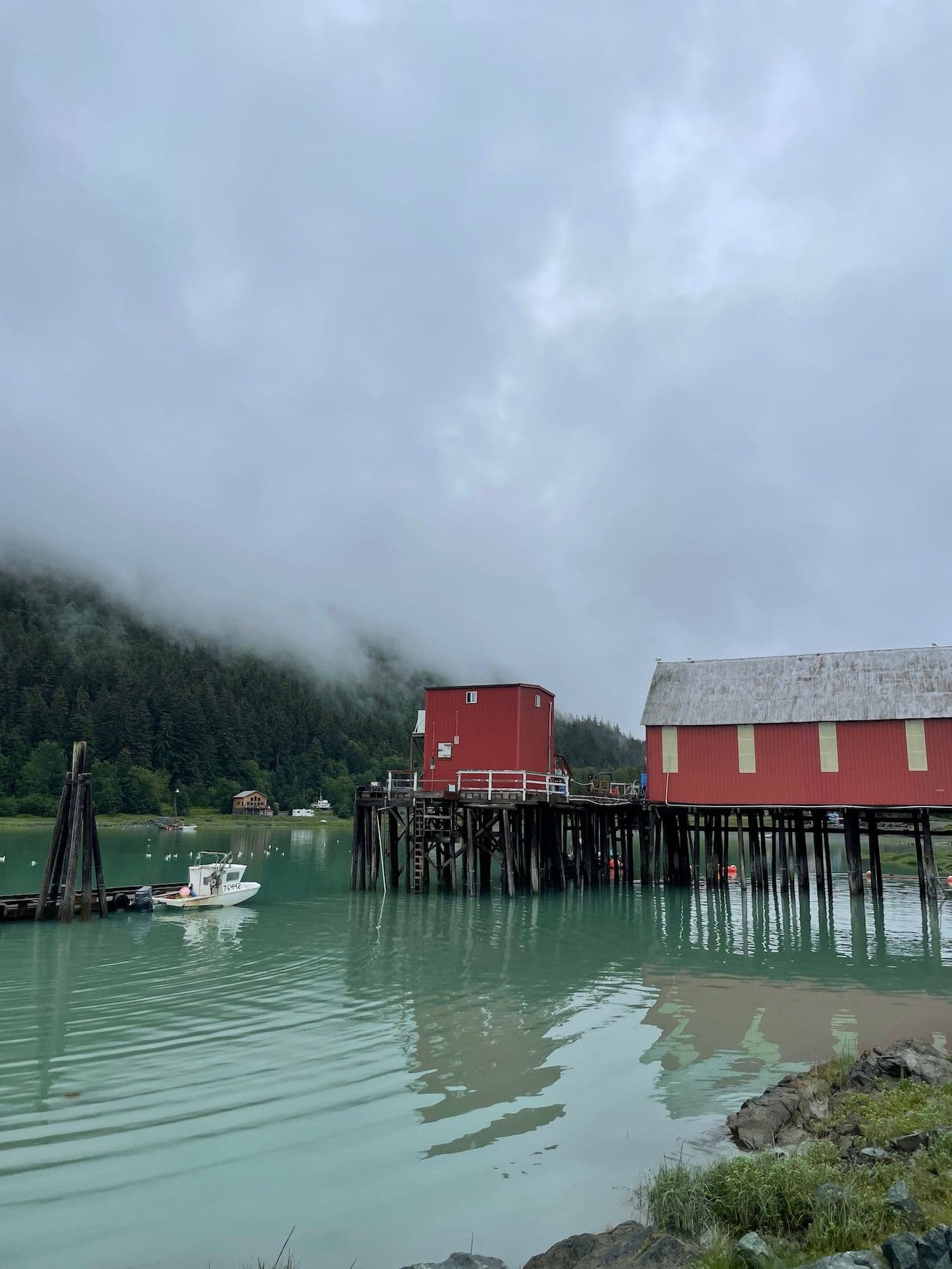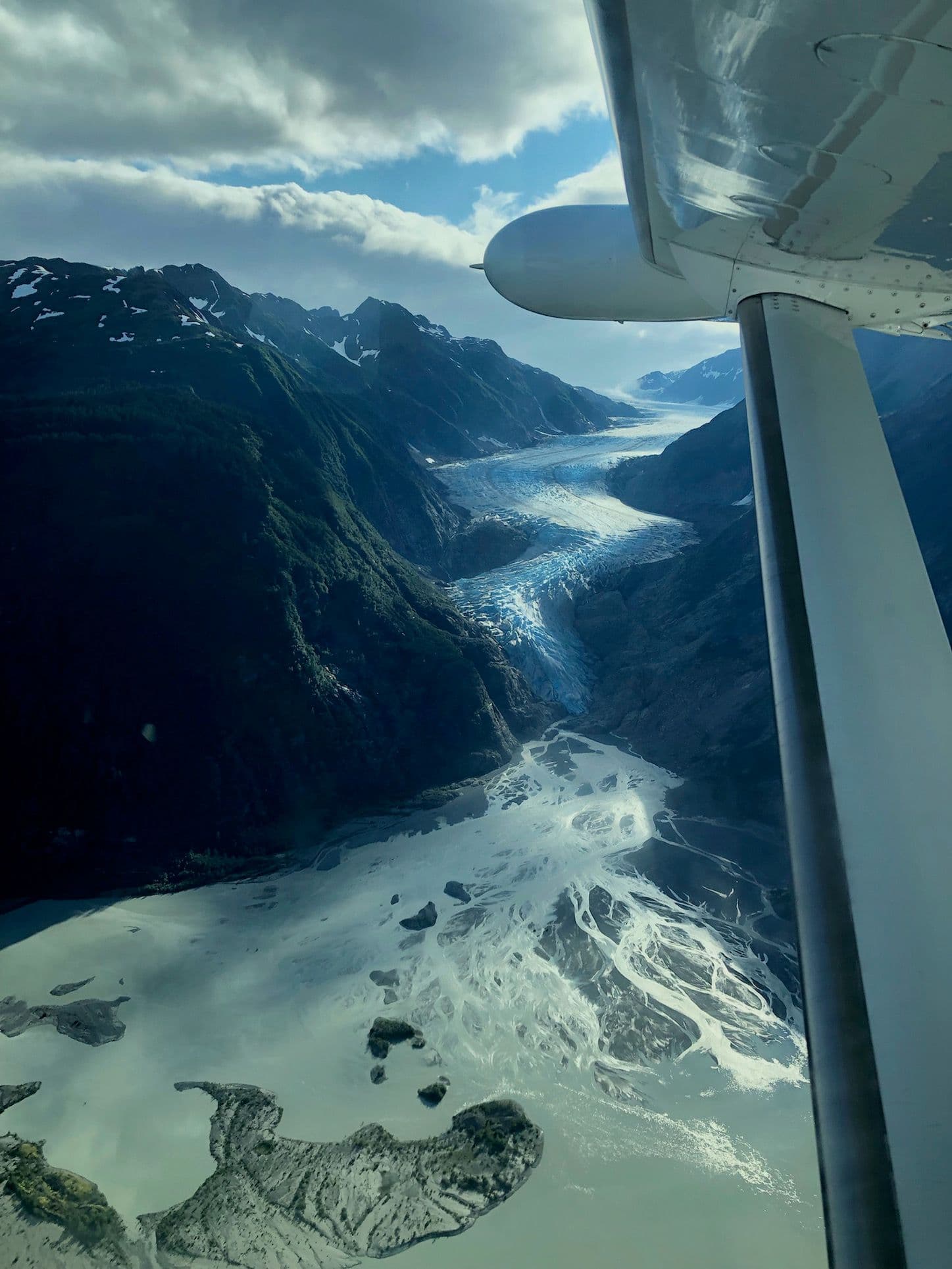I stand in the rain while I wait to meet Sarah Frances
“It wasn’t always like this, I swear.” As soon as I sit down, Sarah starts apologizing for the state of her car. “A bear got trapped inside the trunk a few years back and tore up the interior before finally letting itself out the driver’s door.” I notice the pink insulation for the first time, dangling from the seams of the windshield like stuffing falling out of a teddy bear. Every single door is either missing a handle entirely or it’s hanging by wires. My seatbelt is chewed into two pieces. I laugh. Having grown up in Alaska, I’m familiar with cars (and boats) whose uniqueness is surpassed only by the stories that accompany them.
We drive out to Letnikof Cove where Haines Packing Company is located and I enjoy a moment watching, rather than being immersed in, the drippy, misty weather as we chat inside the warm car (heating seems to be functional despite the bear). Sarah used to gillnet fish before working on a tender boat near Elfin Cove. Tenders are boats that go out on the fishing grounds to pick up fish and drop off supplies like ice, food, and fuel so that fishermen can stay out and continue fishing. These days she’s a one-woman Human Resources department, fleet manager, compliance officer, fish ticket-writer, and crew coordinator at Haines Packing Co.

When we turn the corner into the cove, the cannery across the bay comes into view. The deep red of the buildings stand out against the turquoise blue waters of the Chilkat River. The river, located at the head of Lynn Canal, is home to all five types of Pacific salmon as well as Dungeness crab, coonstripe shrimp, and Pacific halibut.

You could say that the folks at Haines Packing Co. are literally surrounded by seafood. Located on an isthmus, the town of Haines is sandwiched between the two largest sockeye-producing rivers in Southeast Alaska, the Chilkat and Chilkoot watersheds, at the point where they meet in the upper Lynn Canal.

This stretch of water is both the deepest fjord in the United States and one of its most abundant. It provides Dungeness crab, coho, keta, and sockeye salmon—harvested by small-scale crabber and gillnet boats—for Sitka Seafood Market members. These fishing vessels are owned and operated primarily by local Haines fishermen who catch fish up and down the inside passage—carving out the distinctive corners of each fishery and often switching between fisheries to maintain their livelihoods as year-round harvesters of Lynn Canal.
Today there’s a seiner-turned-tender boat pulled up at the dock. Sarah and I get out of the car and she starts a tour of the plant. She tells me that Haines Packing Co. is the oldest fish processing plant and cannery in Alaska. Its charm is undeniable.

All the original 1910 wooden buildings are still in use, well maintained, and painted a deep vintage red that, according to Sarah, is original as well. There have been a number of improvements over the years, including a new processing room added onto the first-floor fillet room and a small office space above it for Sarah and the owner, Harry Reitze. We tour the facilities and I chat with the staff who kindly answer my questions while rushing to process a load of sockeye salmon.

By the time I sit down to talk with Harry, I've already heard so many positive things about him that I’m not surprised to find that his air is easy, self-effacing, and kind. He grew up watching his father run the plant—learning the operations before stepping in to run them at the young age of 22. After formally taking over the business in 2012, the cannery grew each year.

In fact, Harry says that their small fleet of gillnetters has nearly doubled in the last five years. Harry handpicks each fleet member based on their reputation as responsible fishermen that produce high-quality, well-iced, well-bled fish. In 2016, the plant added its first tender boat to the fleet. Six years later, the processor is now servicing its fleet with four tenders.

One of those boats is the F/V Western Viking, the seiner-turned-tender boat that we saw down at the dock. I walk down to chat with its captain, Al Smith. Al is a polite and talkative man in his mid-70s who invites me aboard to talk. A large photo of his granddaughter petting a dog hangs in his impeccably clean galley. Al has been tendering for Haines Packing Co. for four years now, but his time on fishing boats stretches over half a century and across the entire Pacific coast of North America.

Al’s first fishing job was working on a 20-foot gillnetter skiff in Puget Sound in 1964. “Back in those days,” he says, “the fishing openers were at night and we would have to pull the nets by hand.” Al’s seen a hard day’s (and night’s) work and he says that this week in particular “we worked hard.” The high volume of sockeye requires frequent offloads to the plant in order to maintain top-quality fish in a tight timeframe.
In fact, Harry tells me that at the height of the season, like this week, tenders make two to three rounds per day to pick up fish. That means that Harry’s crew is working overtime to get all the fish filleted and into the freezer quickly.

Sarah and I walk up into the fillet room and wave at the team. Tejano music plays over the speakers as men and women work cutting fish. Many workers are from Mexico and Guatemala and they smile at my fumbling Spanish. Kevin Chanaz, who oversees glazing, and has worked with Harry for eight years now, tells me that the crew is glad to be able to make a great wage working overtime for a short period of time so that they can be quickly reunited with their families. For Kevin, he says a big reason that he likes working at the company is Harry. “It’s the working environment. We can go to Harry and have our thoughts heard. He goes the extra mile because he really cares about the workers especially when he knows we’re away from our families.”

Sarah is quick to add that the success of the cannery is also because they have such a great crew of workers. “We’ve had the same people coming back for years,” she says. Frankly, I’m impressed. Fishing is a high-intensity industry and burnout can be common—especially in seafood plants where long hours are part of what is required to move fish quickly into the freezer to maintain premium taste and texture.
Having a crew that returns year after year is a testament to the quality of the longstanding relationships here at Haines Packing Co. Just as Harry handpicks his fishermen based on reputation, the workers continue to choose to work for him based on their rapport which is evident as we tour the plant.




